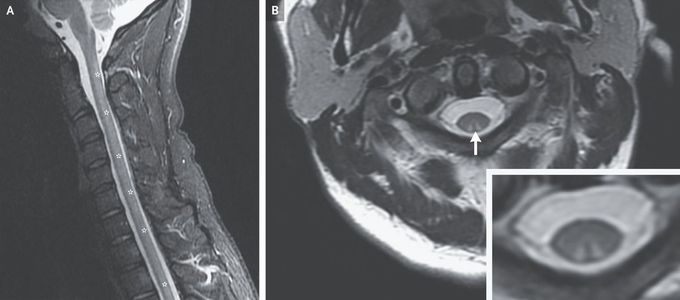


Subacute Combined Degeneration from Nitrous Oxide Use
A 32-year-old man presented to the emergency department with a 6-week history of tingling in his arms and legs and a 2-week history of inability to walk. Two months before presentation, he had begun inhaling nitrous oxide — also known as “whippets” or “laughing gas” — daily. On physical examination, the Romberg test was positive, and sensory ataxia, impaired proprioception and vibratory sensation, and preserved nociception were noted. Magnetic resonance imaging of the whole spine showed hyperintensity in the posterior spinal cord from C1 to T12 on T2-weighted images (Panel A, asterisks). Axial images revealed a lesion in the dorsal column that was hyperintense on both T2-weighted images and fluid-attenuated inversion recovery (FLAIR) sequence, a finding known as the “inverted-V sign” that is seen in subacute combined degeneration (Panel B, arrow and inset). The patient’s vitamin B12 level was 107 pg per milliliter (reference value, >231). There was no macrocytic anemia. Antibody testing for autoimmune gastritis was negative. A diagnosis of subacute combined degeneration associated with nitrous oxide use was made. Long-term use of nitrous oxide causes the inactivation of vitamin B12, which then interrupts methionine synthase activity. After the patient ceased nitrous oxide use and received treatment with cyanocobalamin injections for 2 weeks, his vitamin B12 level normalized. At the 4-week follow-up, he was able to walk independently.

